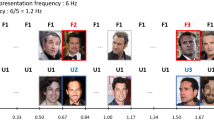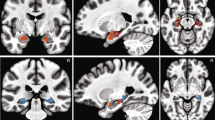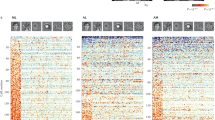Abstract
A split-brain patient (epileptic individual whose corpus callosum had been severed to minimize the spread of seizure activity) was asked to recognize morphed facial stimuli—presented separately to each hemisphere—as either himself or a familiar other. Both hemispheres were capable of face recognition, but the left hemisphere showed a recognition bias for self and the right hemisphere a bias for familiar others. These findings suggest a possible dissociation between self-recognition and more generalized face processing within the human brain.
This is a preview of subscription content, access via your institution
Access options
Subscribe to this journal
Receive 12 print issues and online access
$209.00 per year
only $17.42 per issue
Buy this article
- Purchase on Springer Link
- Instant access to full article PDF
Prices may be subject to local taxes which are calculated during checkout


Similar content being viewed by others
References
Keenan, J.P. et al. Trends Cogn. Sci. 4, 338–344 (2000).
Kircher, T.T.J. et al. Cogn. Brain Res. 10, 133–144 (2000).
Kircher, T.T.J. et al. Cognition 78, 1–15 (2001).
Kirchner, T.T.J. et al. Neuropsychologia 40, 683–693 (2002).
Keenan, J.P. et al. Nature 409, 305 (2001).
Haxby, J.V., Hoffman, E.A. & Gobbini, M.I. Trends Cogn. Sci. 4, 223–233 (2000).
De Renzi, E. Neuropsychologia 24, 385–389 (1994).
Gazzaniga, M.S. & Smylie, C.S. Ann. Neurol. 13, 536–540 (1983).
Keenan, J.P. et al. Neuropsychologia 37, 1421–1425 (1999).
Keenan, J.P. et al. Neuropsychologia 38, 1047–1053 (2000).
Conway, M.A. & Pleydell-Pearce, C.W. Psychol. Rev. 107, 261–288 (2000).
Conway, M.A. et al. Memory 7, 679–702 (1999).
Maguire, E.A. & Mummery, C. Hippocampus 9, 54–61 (1999).
Gazzaniga, M.S. Sci. Am. 279(6), 51–55 (1998).
Acknowledgements
The authors thank B. Walling for help with the data collection. This work was supported by National Science Foundation grant BCS 0072861 and by National Institutes of Health grant RO1 NS31443.
Author information
Authors and Affiliations
Corresponding author
Ethics declarations
Competing interests
The authors declare no competing financial interests.
Rights and permissions
About this article
Cite this article
Turk, D., Heatherton, T., Kelley, W. et al. Mike or me? Self-recognition in a split-brain patient. Nat Neurosci 5, 841–842 (2002). https://doi.org/10.1038/nn907
Received:
Accepted:
Published:
Issue Date:
DOI: https://doi.org/10.1038/nn907
This article is cited by
-
Behavioural and ERP evidence of the self-advantage of online self-relevant information
Scientific Reports (2020)
-
Encoding asymmetry within neural circuits
Nature Reviews Neuroscience (2012)
-
The Perception and the Recognition of Human Faces and their Emotional Expressions — In Healthy Subjects and Schizophrenic Patients
Activitas Nervosa Superior (2011)



